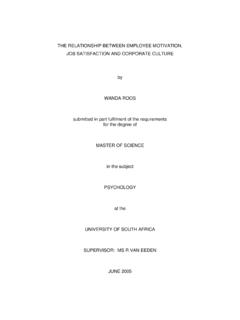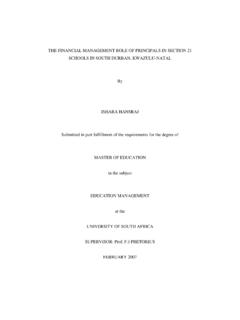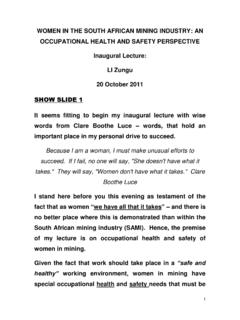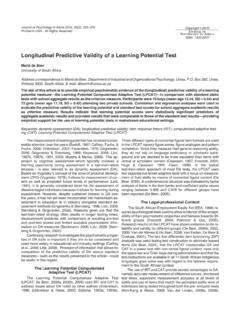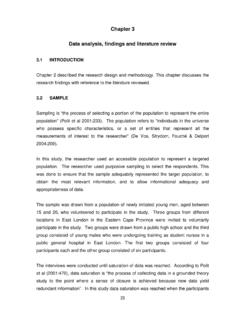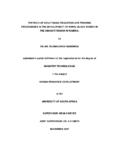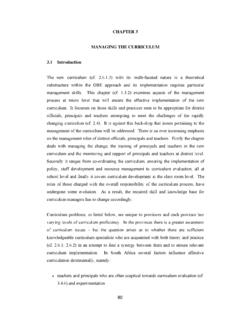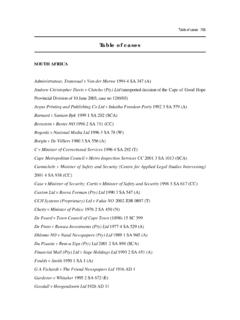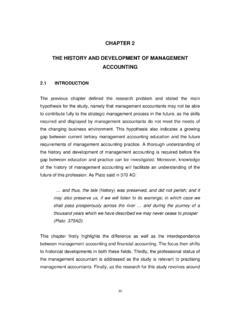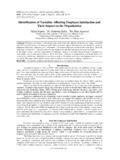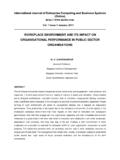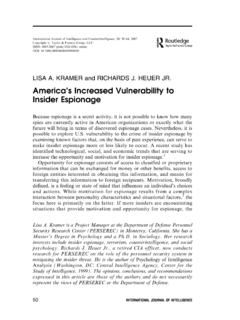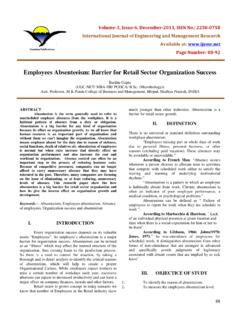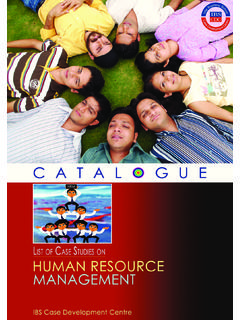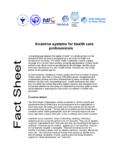Transcription of THE UNIQUE FACTORS AFFECTING EMPLOYEE …
1 THE UNIQUE FACTORS AFFECTING EMPLOYEE performance IN NON. PROFIT ORGANISATIONS. by CHARITY TINOFIREI. submitted in accordance with the requirements for the degree of MAGISTER TECHNOLOGIAE. in the subject PUBLIC MANAGEMENT. at the UNIVERSITY OF SOUTH AFRICA. SUPERVISOR: DR E G BAIN. CO-SUPERVISOR: MS R G WESSELS. NOVEMBER 2011. Page | i ACKNOWLEDGEMENTS. _____. I would like to thank God, for through Him, all things are possible. I dedicate this degree to the following people who have made me who I. am and have walked with me in one way or another through this journey: My parents, who instilled in me a culture of reading, learning and being the best that I can be, thank you.
2 My family who have been there for me and have tolerated and accommodated my unavailability, while I pursued completion of this degree. Your strength and unwavering support inspire me. My dearest BFFs who continue to inspire me to even greater achievements, personally and professionally. My colleagues for affording me the time and space to conduct this research. I am immensely grateful for the guidance, direction and patience shown by my supervisor and co-supervisor, Dr EG Bain and Ms R Wessels. Thank you to the department librarian Ms Melanie Malan, for invaluable support and access to hard-to-find books and journals.
3 Michelle, this one is for you. Work hard, never stop dreaming and believing. Page | ii SUMMARY. _____. The research explored UNIQUE performance enhancing or inhibiting FACTORS among Zimbabwean employees in non-profit organisations in Harare. Two research questions were formulated: Are there UNIQUE work ethics inherent in employees in the non-profit sector? The second research question is What UNIQUE variables motivate and affect workers in the non- profit sector? The hypothesis assumed was that the workplace performance of employees in the non-profit sector is affected by and dependent on UNIQUE FACTORS that apply in the non-profit sector and not in profit sectors.
4 The analysis of the research sample identified UNIQUE performance FACTORS : demotivation due to the absence of automatic promotions for high performing employees; opportunities for the advancement of employees through a policy of competitive recruitment and growth opportunities for local staff who can apply for international positions within the organisation. The hypothesis was accepted. The researcher recommended that non-profit organisations use creative sector-specific approaches to motivate EMPLOYEE performance . Key words: performance , EMPLOYEE performance , performance management, productivity, motivation, UNIQUE motivating FACTORS , Zimbabwe, non-profit organisations, public organisations, non-governmental organisations.
5 Page | iii LIST OF TABLES AND FIGURES. _____. TITLE PAGE. Figure Maslow s Hierarchy of Needs 33. Figure Interactive Data Analysis Model 60. Table Questionnaire Response Rate 63. Figure Chart indicating the questionnaire response rate 63. Table Number of respondents by gender 64. Table Respondents age bands segregated by gender 65. Table Respondents marital status segregated by gender 66. Table Number of years a respondent has worked in 67. current position Figure Number of years a respondent has worked in 68. current position Table Number of employers since 2005 70.
6 Table Number of employees per contract type 73. Table Highest qualification held 79. Table Number of employees per grade level 80. Table Summary of financial and non-financial rewards 82. Page | iv TABLE OF CONTENTS. _____. Declaration i Acknowledgements ii Summary iii List of figures and tables iv Table of contents v CHAPTER 1. INTRODUCTION AND OVERVIEW ..1. INTRODUCTION ..1. BACKGROUND AND STIMULUS FOR THE RESEARCH ..2. Zimbabwean context ..4. Context of the research period ..4. Limitations of the research ..7. Previous studies ..8. SCOPE OF RESEARCH.
7 9. Rationale for the study ..9. RESEARCH QUESTION .. 10. Research sub-questions .. 10. RESEARCH 10. 11. TERMINOLOGY .. 11. Non-profit organisations .. 11. performance .. 12. performance management and 13. Productivity .. 13. Motivation .. 14. Summarised definition of EMPLOYEE performance .. 15. RESEARCH 15. Variables to be considered .. 16. Summary of the research methodology .. 16. Qualitative and Quantitative data .. 16. DIVISION OF 19. CONCLUSION .. 20. CHAPTER 2. MOTIVATIONAL THEORIES AND performance MANAGEMENT. FACTORS .. 21. INTRODUCTION.
8 21. EMPLOYEES AS ORGANISATIONAL RESOURCES .. 22. EMPLOYEE performance management in a non-profit organisation a comparative case study .. 24. MOTIVATIONAL THEORIES .. 27. Bennis Participatory Management .. 27. Deming s Total Quality Management .. 28. Mayo s Hawthorne Effect .. 30. McClelland s Motivational Needs Theory .. 31. Page | v Achievement motivational need .. 31. Authority motivational 31. Affiliation motivational need .. 32. Maslow s Motivation 33. McGregor s Theory X, Theory Y .. 34. HUMAN RESOURCES performance MANAGEMENT. 36.
9 External FACTORS in EMPLOYEE 36. performance evaluations or appraisals .. 37. Remuneration .. 37. Leadership style .. 40. Career movements .. 40. Internal FACTORS in EMPLOYEE performance .. 41. The EMPLOYEE s role in performance .. 41. CONCLUSION .. 42. CHAPTER 3. METHODOLOGY .. 44. INTRODUCTION .. 44. RESEARCH DESIGN .. 44. RELIABILITY .. 46. ERROR VARIANCE .. 46. 47. VALIDITY .. 47. QUALITY OF DATA .. 49. CORRELATIONS, UNI-VARIATE AND BI-VARIATE. RELATIONSHIPS .. 49. STATISTICAL INFERENCE AND SIGNIFICANCE .. 50. SAMPLE SIZE .. 51. DATA COLLECTION METHODS.
10 52. Questionnaire .. 52. Pre-testing of the questionnaire .. 53. Exclusion question, consent and anonymity .. 53. Categorising sections within the questionnaire .. 53. Funnelling technique .. 54. Five-point attitudinal scale .. 54. Central tendency, response and order bias .. 55. Sections within the questionnaire .. 56. Focus group session .. 56. Semi-structured interview sessions .. 56. METHODS OF DATA 58. Quantitative data .. 58. Analysis of quantitative data .. 58. Qualitative data .. 59. Analysis model of qualitative data .. 59. CONCLUSION.
